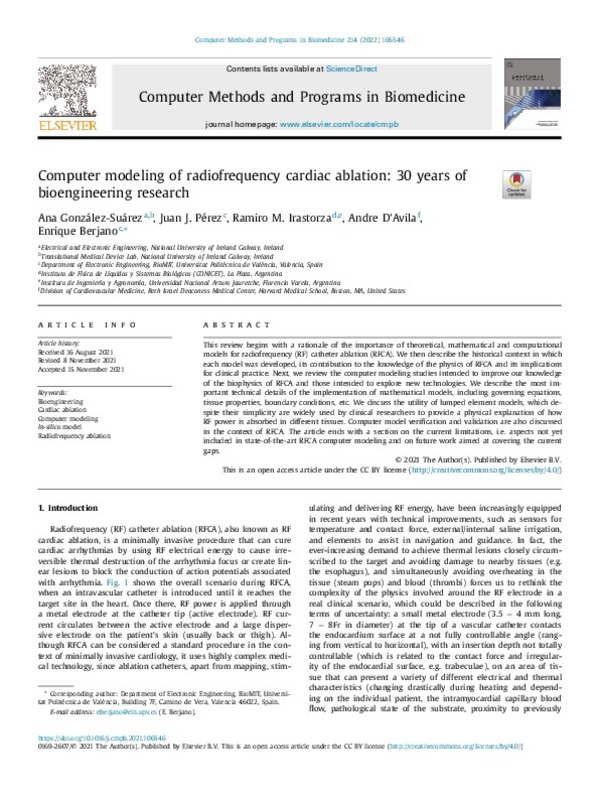JavaScript is disabled for your browser. Some features of this site may not work without it.
Buscar en RiuNet
Listar
Mi cuenta
Estadísticas
Ayuda RiuNet
Admin. UPV
Computer modeling of radiofrequency cardiac ablation: 30 years of bioengineering research
Mostrar el registro sencillo del ítem
Ficheros en el ítem
| dc.contributor.author | González-Suárez, Ana
|
es_ES |
| dc.contributor.author | Pérez, Juan J
|
es_ES |
| dc.contributor.author | Irastorza, Ramiro M.
|
es_ES |
| dc.contributor.author | D Avila, Andre
|
es_ES |
| dc.contributor.author | Berjano, Enrique
|
es_ES |
| dc.date.accessioned | 2022-04-27T06:27:49Z | |
| dc.date.available | 2022-04-27T06:27:49Z | |
| dc.date.issued | 2022-02 | es_ES |
| dc.identifier.issn | 0169-2607 | es_ES |
| dc.identifier.uri | http://hdl.handle.net/10251/182126 | |
| dc.description.abstract | [EN] This review begins with a rationale of the importance of theoretical, mathematical and computational models for radiofrequency (RF) catheter ablation (RFCA). We then describe the historical context in which each model was developed, its contribution to the knowledge of the physics of RFCA and its implications for clinical practice. Next, we review the computer modeling studies intended to improve our knowledge of the biophysics of RFCA and those intended to explore new technologies. We describe the most important technical details of the implementation of mathematical models, including governing equations, tissue properties, boundary conditions, etc. We discuss the utility of lumped element models, which despite their simplicity are widely used by clinical researchers to provide a physical explanation of how RF power is absorbed in different tissues. Computer model verification and validation are also discussed in the context of RFCA. The article ends with a section on the current limitations, i.e. aspects not yet included in state-of-the-art RFCA computer modeling and on future work aimed at covering the current gaps | es_ES |
| dc.description.sponsorship | Grant RTI2018-094357-B-C21 funded by MCIN/AEI/10.13039/501100011033 (Spanish Ministerio de Ciencia, Innovación y Universidades/Agencia Estatal de Investigación) | es_ES |
| dc.language | Inglés | es_ES |
| dc.publisher | Elsevier | es_ES |
| dc.relation.ispartof | Computer Methods and Programs in Biomedicine | es_ES |
| dc.rights | Reconocimiento (by) | es_ES |
| dc.subject | Bioengineering | es_ES |
| dc.subject | Cardiac ablation | es_ES |
| dc.subject | Computer modeling | es_ES |
| dc.subject | In-silico model | es_ES |
| dc.subject | Radiofrequency ablation | es_ES |
| dc.subject.classification | TECNOLOGIA ELECTRONICA | es_ES |
| dc.title | Computer modeling of radiofrequency cardiac ablation: 30 years of bioengineering research | es_ES |
| dc.type | Artículo | es_ES |
| dc.identifier.doi | 10.1016/j.cmpb.2021.106546 | es_ES |
| dc.relation.projectID | info:eu-repo/grantAgreement/AEI/Plan Estatal de Investigación Científica y Técnica y de Innovación 2017-2020/RTI2018-094357-B-C21/ES/MODELADO Y EXPERIMENTACION PARA TERAPIAS ABLATIVAS INNOVADORAS/ | es_ES |
| dc.rights.accessRights | Abierto | es_ES |
| dc.contributor.affiliation | Universitat Politècnica de València. Departamento de Ingeniería Electrónica - Departament d'Enginyeria Electrònica | es_ES |
| dc.description.bibliographicCitation | González-Suárez, A.; Pérez, JJ.; Irastorza, RM.; D Avila, A.; Berjano, E. (2022). Computer modeling of radiofrequency cardiac ablation: 30 years of bioengineering research. Computer Methods and Programs in Biomedicine. 214:1-16. https://doi.org/10.1016/j.cmpb.2021.106546 | es_ES |
| dc.description.accrualMethod | S | es_ES |
| dc.relation.publisherversion | https://doi.org/10.1016/j.cmpb.2021.106546 | es_ES |
| dc.description.upvformatpinicio | 1 | es_ES |
| dc.description.upvformatpfin | 16 | es_ES |
| dc.type.version | info:eu-repo/semantics/publishedVersion | es_ES |
| dc.description.volume | 214 | es_ES |
| dc.identifier.pmid | 34844766 | es_ES |
| dc.relation.pasarela | S\453731 | es_ES |
| dc.contributor.funder | AGENCIA ESTATAL DE INVESTIGACION | es_ES |
| upv.costeAPC | 2440 | es_ES |








